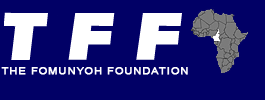Survey Background
The 2008 Bamenda Radio Listenership Survey was carried out in collaboration between Foundation Radio and the Youth Outreach Programme and organized by Audrey Bottjen and Nicholas Wexler, MA Candidates of the Johns Hopkins School of Advanced International Studies.
 Between June 30-July 1,21 youths from the Youth Outreach Programme, aged between 12 and 29, were given training to design, create and implement a city-wide survey. Over the following three days, from July 2-4, these youths carried out the survey in neighborhoods and quarters around Bamenda, and surrounding villages. The surveyors worked in ten teams of two (and in one case, three), with one surveyor acting as the interviewer, and the other as the recorder. Each team was given a 40-page notebook in which to record the answers, with each interview expected to take the front and back of one page. Each interview was expected to take not more than 10 minutes, with an estimated 20 minutes between interviews. Therefore, it was expected that each team could conduct 10 interviews in the space of about five hours. Having ten teams, conducting ten interviews a day, for three days should then yield 300 surveys. In fact, we received 309, allowing us to winnow out some of the interviews which were judged to be incomplete or contaminated, bringing the final number to exactly 300. Between June 30-July 1,21 youths from the Youth Outreach Programme, aged between 12 and 29, were given training to design, create and implement a city-wide survey. Over the following three days, from July 2-4, these youths carried out the survey in neighborhoods and quarters around Bamenda, and surrounding villages. The surveyors worked in ten teams of two (and in one case, three), with one surveyor acting as the interviewer, and the other as the recorder. Each team was given a 40-page notebook in which to record the answers, with each interview expected to take the front and back of one page. Each interview was expected to take not more than 10 minutes, with an estimated 20 minutes between interviews. Therefore, it was expected that each team could conduct 10 interviews in the space of about five hours. Having ten teams, conducting ten interviews a day, for three days should then yield 300 surveys. In fact, we received 309, allowing us to winnow out some of the interviews which were judged to be incomplete or contaminated, bringing the final number to exactly 300.
Each team was responsible for a distinct geographic area, representing the different demographic, ethnic and socio-economic groups present in Bamenda and its surrounding areas. These areas were:
- Up-station
- Sonac Sheet
- Bali Park
- Nghomgam
- Mendankwe
- Commercial Avenue
- Ntarinkon
- Bambili
- Nkwen
- Food Market
- Old town
 After the survey was implemented, and the data was tabulated, a focus group was held with a number of the surveyors to go over the initial findings for purposes of interpretation and context, as well as an evaluation of the overall efficacy of the survey as an instrument. After the survey was implemented, and the data was tabulated, a focus group was held with a number of the surveyors to go over the initial findings for purposes of interpretation and context, as well as an evaluation of the overall efficacy of the survey as an instrument.
Taking into account the observations of the focus group and an analysis of the data, several general, though by no means exhaustive, observations can be made from the survey results:
In regards to programme content, respondents indicated a strong desire for news, both local and international. Indeed, news far outranked other types of programmes preferred. Furthermore, respondents overwhelmingly indicated "news" as the reason for why a station was their favorite
- Regarding types of music preferred, respondents most commonly expressed preferences for gospel music and various styles of Cameroonian music
- After three months on air, Foundation Radio is listened to regularly by a small percentage (6%) of all respondents, however the station's existence is widely known
- Currently, Foundation Radio's listenership appears to skew to an under 35 age demographic
- Regular Foundation Radio listeners appear to be significantly more likely than the general pool of respondents to have bought a product they heard advertised on the radio
Following are the full results and analyses stemming from the survey responses. This information is intended to help shape Foundation Radio's pursuit of its mission; through programming, marketing, and outreach. Furthermore, it is hoped that this survey, taken only three months after the station has begun broadcasting, can also serve as a benchmark for future surveys and evaluations, so that Foundation Radio may be able to concretely evaluate its efforts and its impact on the community.
|

